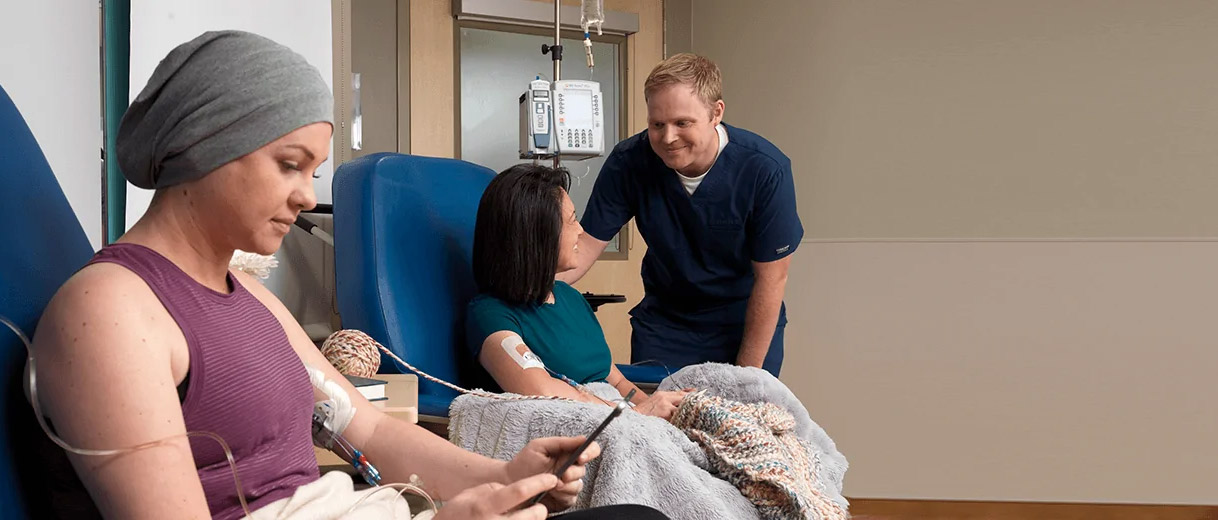PICC line or port catheter: Which one for cancer patients?
It can be challenging knowing when to insert a peripherally inserted central catheter (PICC line) or port catheter into patients with cancer. The choice of central venous catheter (CVC) is critical in oncology. As an oncology professional, you have multiple factors to consider. Different options involve different benefits and potential complications.
What are the advantages of PICC lines?
Oncological drugs and central venous access were developed after the end of World War II. The port catheter was invented around 1970.
PICC lines have been available since the 1970s, but their use has increased significantly since 2000 for several reasons1:
- Ease of placement
- Ultrasound guidance ensures proper position
- Lower cost of insertion compared to other CVCs
- Lower risk of bleeding
- Ease of removal
What are the potential risks associated with CVCs?
1. What is the risk of BSIs between different CVCs?
Chopra et al performed a systematic review comparing complication rates between PICCs and other CVCs2. According to the results, PICC lines placed in inpatients were twice as likely to cause bloodstream infections (BSIs) than those placed in outpatients2.
2. What is the risk of thrombosis between port catheters and PICC lines?
Thrombosis is more common in patients with cancer than those without cancer5. In systematic reviews conducted by Saber et al. and Yeow et al., it was found that thrombosis rates were higher in patients with PICCs than those with port catheters6,7.
However, Chopra et al. suggested that the rates of thrombosis for PICCs may vary based on the techniques used to place them5.
Ultrasound navigation equipment can be used to ensure placement in the appropriate vessel3.
3. What are the rates of IV catheter-related complications for PICC lines?
Prof. Baudolino Mussa from the University of Turin and colleagues carried out a prospective study on PICCs in outpatients with cancer3. They found that rates of IV catheter-related complications (CRBSIs, thrombosis and mechanical complications) were low with PICCs3.
The main finding of Mussa et al. was that when PICCs are maintained properly using evidence-based protocols, they have relatively low rates of complications; are less likely to be removed because of complications; and provide long catheter life spans3.
4. Can PICCs be a safe method for administering chemotherapy?
In a seven-year study of 2,477 patients, Campagna et al. found that PICCs can be safe for administering oncological drugs in the medium- to long-term with low rates of infection and thrombosis8.
Choose a CVC adapted to the specific needs of your patients
When can port catheters be used?
Mielke et al. recommend against using port catheters for less than 30 days4. They should not be placed for standard radiation protocols (less than 60 days) either4.
When can PICCs be used?
According to Mussa et al., PICCs may be used safely in oncology patients if they are inserted and managed correctly3. Their duration can be extended from a few weeks to up to 6 months4. Unlike port catheters which require minor surgery for placement, PICCs offer the advantage of a lower risk of procedure-related trauma4.
The bottom line: One CVC doesn’t fit all
The same CVC cannot be used in all patients. It is important to choose the appropriate CVC based on the patient’s needs9. Prof. Mussa thinks this strategy may be able to reduce costs, lessen pain for patients and improve treatment quality. For more information, watch his presentation on this topic.
References
- Falzone L, Salomone S, Libra M. Evolution of Cancer Pharmacological Treatments at the Turn of the Third Millennium. Front Pharmacol. 2018;9:1300. doi: 10.3389/fphar.2018.01300
- Li G, Zhang Y, Ma H, Zheng J. Arm port vs chest port: a systematic review and meta-analysis. Cancer Manag Res. 2019 Jul 3;11:6099-6112. doi: 10.2147/CMAR.S205988
- Cotogni P, Barbero C, Garrino C, et al. Peripherally inserted central catheters in non-hospitalized cancer patients: 5-year results of a prospective study. Support Care Cancer. 2014;23(2):403-409.
- Mielke D, Wittig A, Teichgräber U. Peripherally inserted central venous catheter (PICC) in outpatient and inpatient oncological treatment. Support Care Cancer. 2020;28(10):4753-4760. doi: 10.1007/s00520-019-05276-0
- Chopra V, Anand S, Krein SL, Chenoweth C, Saint S. Bloodstream infection, venous thrombosis, and peripherally inserted central catheters: reappraising the evidence. Am J Med. 2012;125(8):733-741.
- Saber W, Moua T, Williams EC, et al. Risk factors for catheter-related thrombosis (CRT) in cancer patients: a patient-level data (IPD) meta-analysis of clinical trials and prospective studies. J Thromb Haemost. 2011;9(2):312-319.
- Yeow M, Soh S, Yap R, Tay D, Low YF, Goh SSN, Yeo CS, Lo ZJ. A systematic review and network meta-analysis of randomized controlled trials on choice of central venous access device for delivery of chemotherapy. J Vasc Surg Venous Lymphat Disord. 2022:S2213-333X(22)00171-8. doi: 10.1016/j.jvsv.2022.03.007
- Campagna S, Gonella S, Berchialla P, et al. Can Peripherally Inserted Central Catheters Be Safely Placed in Patients with Cancer Receiving Chemotherapy? A Retrospective Study of Almost 400,000 Catheter-Days. Oncologist. 2019;24(9):e953-e959.
- Campagna S, Gonella S, Zerla PA, et al. The Risk of Adverse Events Related to Extended-Dwell Peripheral Intravenous Access. Infect Control Hosp Epidemiol. 2018;39(7):875-877.
This presentation contains the personal and professional opinions of the individual speaker and are not necessarily those of Becton, Dickinson and Company (“BD”) or any Business Unit or affiliate of BD.
This list of references to third-party peer-reviewed material and the sites they are hosted on are provided for your reference and convenience only, and do not imply any review or endorsement of the material or any association with their operators. The Third-Party References (and the Web sites to which they link) may contain information that is inaccurate, incomplete, or outdated. Your access and use of the Third Party Sites (and any Web sites to which they link) is solely at your own risk.
BD-61755




